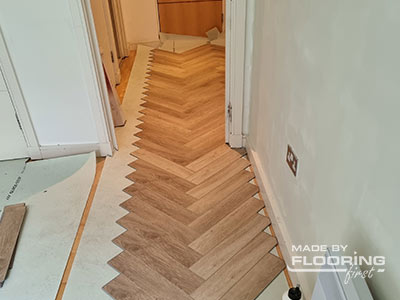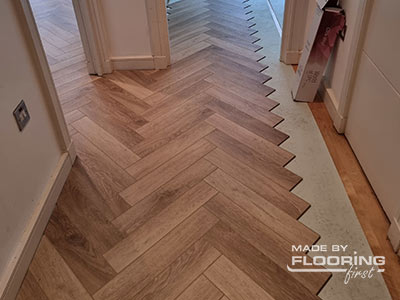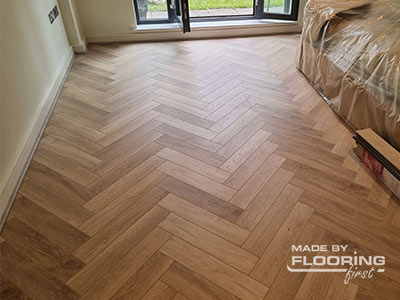Back to Wood Floor Fitting
Can You Lay Vinyl On Hardwood Floors?

Yes, installing vinyl flooring over existing hardwood floors is possible and can be an efficient way to update your space. However, it's essential to ensure proper preparation to achieve a durable and visually appealing result. This guide will walk you through the necessary steps, considerations, and best practices for laying vinyl over hardwood flooring.
Benefits of Installing Vinyl Over Hardwood
Laying vinyl over existing hardwood flooring can be a smart, practical solution—especially if your current floors are structurally sound but visually outdated. Here are some of the key benefits:
- Quick and Easy Installation
Vinyl flooring can be laid directly over hardwood with minimal preparation, meaning there’s no need for messy or time-consuming demolition. It’s a great option if you want fast results with less disruption.
- Cost-Effective Alternative
Instead of paying to sand and refinish your hardwood—or replacing it entirely—vinyl offers a much more affordable way to refresh your floors while still achieving a stylish look.
- Endless Design Options
From authentic wood-look planks to tile and stone finishes, vinyl flooring comes in a wide range of colours, patterns, and textures. This makes it easy to match your décor and achieve the aesthetic you want.
- Comfort and Sound Reduction
Vinyl provides a softer, warmer feel underfoot compared to hardwood, and often includes sound-absorbing properties—ideal for busy households or flats with neighbours below.
Important Note:
While vinyl has many advantages, skipping essential preparation steps—such as surface levelling or moisture control—can result in long-term issues like buckling, lifting, or mould growth. Proper installation is key to lasting performance.
What to Consider Before Installing Vinyl Over Hardwood
Before you lay vinyl flooring over hardwood, it’s essential to evaluate whether your existing floor is suitable. Skipping this step can lead to uneven finishes, adhesive failure, or long-term moisture problems. Here's what you need to check:
Subfloor Condition
Your hardwood must be in excellent condition to support vinyl flooring. That means:
- Level and smooth – There should be no noticeable dips, cupping, or raised boards. If necessary, use a floor leveller or sand down high spots to create an even surface.
- Secure and squeak-free – Loose or creaky boards must be nailed or screwed down. Movement under the vinyl can lead to damage or instability over time.
- Clean and dry – Sweep, vacuum, and wipe down the floor to remove dust, debris, or any sticky residue. These can interfere with vinyl adhesion and may promote mould growth underneath the flooring.
Moisture Levels
Hardwood is a natural material and can expand or contract with moisture changes. To avoid future issues:
- Use a moisture meter to check your floor's moisture content.
- If readings are high or if you’re installing in a moisture-prone area (like a ground-floor flat), you must apply a damp-proof membrane (DPM).
- Alternatively, use a vinyl underlay with built-in moisture protection, especially if installing over concrete or in humid environments.
Floor Height and Door Clearance
Vinyl flooring will slightly raise your overall floor level. While usually minimal, it’s important to check that:
- Doors can open and close freely once the vinyl is installed. You may need to trim the bottom of the doors.
- Built-in furniture or kitchen units won't be affected by the additional floor height.
- Skirting boards or beading may need adjusting to accommodate the new flooring thickness.
Tip: Always perform a dry layout first, placing a few planks to test fit, alignment, and height before committing to a full installation.
Types of Vinyl Suitable for Hardwood Subfloors

Not all vinyl flooring is created equal, especially when you're installing it over an existing hardwood floor. Choosing the right type ensures better performance, visual appeal, and long-term durability. Here are the most suitable vinyl options:
Luxury Vinyl Planks (LVP)
- Best for: Floating installations using a click-lock system
- Why choose it: LVP is one of the most popular choices for hardwood subfloors. It closely resembles real wood in appearance but offers greater resilience and water resistance.
- Bonus: Installation is quick, clean, and glue-free, making it ideal for DIY projects or temporary solutions.
Glue-Down Vinyl Flooring
- Best for: Smooth, well-prepared hardwood surfaces
- Why choose it: This type of vinyl provides a permanent, stable installation, especially in high-traffic areas. It also feels more solid underfoot due to full contact with the subfloor.
- Tip: Use a high-quality adhesive and follow manufacturer's guidelines for curing times. Proper surface preparation is essential to avoid bubbles or lifting.
Vinyl Sheets
- Best for: Large, open-plan areas
- Why choose it: Sheet vinyl is seamless, making it ideal for rooms where moisture protection and easy cleaning are top priorities (like kitchens or utility rooms).
- Important: The subfloor must be perfectly smooth and flat, as any imperfections will telegraph through the thin material.
Pro Tip: If your hardwood floor has imperfections or uneven patches, floating LVP with a cushioned underlay can be the most forgiving and easiest to work with.
Step-by-Step Guide: How to Install Vinyl Over Hardwood
1. Clean the Hardwood Thoroughly
Start by removing all dust, dirt, grease, and debris from the hardwood floor. Use a vacuum cleaner, followed by a damp (not wet) mop. A clean surface is essential for proper adhesion and prevents imperfections from telegraphing through the vinyl.
2. Repair Any Damage
Inspect the hardwood for:
- Squeaky boards – nail or screw them down securely
- Loose planks – reinforce them to prevent shifting
- Gaps or cracks – fill with wood filler or patching compound
A stable, secure subfloor will give your vinyl a strong foundation and help avoid future movement or noise.
3. Level the Surface
Check for uneven areas using a straightedge or level.
- Sand down high spots and feather out the edges.
- For larger dips or uneven sections, apply a self-levelling compound to create a smooth, flat surface.
This step is critical to achieving a clean, professional finish.
4. Install an Underlay (if required)
Depending on the type of vinyl you're using:
- Click-lock LVP often requires a foam or cork underlay for cushioning and sound reduction.
- For added moisture protection, consider an underlay with a built-in vapour barrier.
- Glue-down vinyl usually does not require an underlay, but may benefit from a primer or bonding layer on the wood surface.
5. Lay the Vinyl Flooring
Follow the specific installation method for your chosen vinyl:
- Floating (click-lock): Start along the longest wall and click planks into place row by row.
- Glue-down: Apply adhesive using the correct trowel, place the vinyl, and roll the floor to remove air pockets.
Always leave an expansion gap (typically 5–10mm) around the perimeter to allow for natural movement.
6. Trim Edges and Fit Thresholds
After the vinyl is laid:
- Use a sharp utility knife to trim excess at the walls or corners.
- Fit transition strips or thresholds between rooms or flooring types for a seamless, finished look.
7. Allow Time to Settle
Let the flooring acclimate to the room’s temperature and humidity (usually 24–48 hours) before placing furniture or walking on it extensively.
For glue-down vinyl, follow the manufacturer’s curing time to allow the adhesive to bond fully.

Common Mistakes to Avoid
While installing vinyl over hardwood can be a smooth process, a few common missteps can compromise the final result. Avoiding these issues will help you achieve a more durable, professional-looking floor:
1. Installing Over Uneven or Damaged Hardwood
Vinyl flooring is thin and flexible, which means any imperfections in the subfloor will show through.
- Uneven boards, dips, or high spots can cause visible bumps or gaps.
- Damaged wood that isn’t repaired can lead to creaking, movement, or even tearing of the vinyl over time.
Solution: Always repair and level the hardwood thoroughly before installation.
2. Skipping Moisture Checks
Moisture is one of vinyl’s biggest enemies, especially when laid over organic materials like wood.
- Excess moisture can lead to mould, mildew, adhesive failure, and warping.
Solution: Use a moisture meter to check humidity levels. Install a damp-proof membrane or moisture-resistant underlay if needed.
3. Using the Wrong Adhesive or Underlay
Each vinyl type requires specific products to perform properly.
- The wrong adhesive may not bond correctly and could loosen over time.
- Inappropriate underlay can cause movement, noise, or moisture issues.
Solution: Always follow the manufacturer's recommendations for compatible adhesives and underlays.
4. Overlooking Expansion Gaps
Vinyl expands and contracts slightly with temperature and humidity changes.
- Without adequate expansion gaps, the flooring may buckle or lift at the edges or seams.
Solution: Leave a 5–10mm gap around the room perimeter, concealed later with skirting or beading.
Avoiding these mistakes ensures a smooth, lasting installation—and protects both your new vinyl floor and the hardwood beneath.
FAQs
Can I install vinyl over damaged hardwood?
Not directly. You’ll need to repair or level the floor first to avoid imperfections telegraphing through the vinyl.
Do I need to remove the old finish on my hardwood?
If you're using glue-down vinyl, lightly sanding off the top finish helps improve adhesive bonding.
Will the vinyl damage the hardwood underneath?
No—if installed correctly, vinyl can protect your hardwood. However, trapped moisture can cause long-term problems if not addressed.
Contact FlooringFirst! for Expert Advice
Need help deciding if vinyl is right for your hardwood floors? Contact FlooringFirst! for a free site visit in London. Our experienced surveyors will assess your floor condition, moisture levels, and recommend the best installation method and products for your space.
Call us today or book a free consultation online to get started.